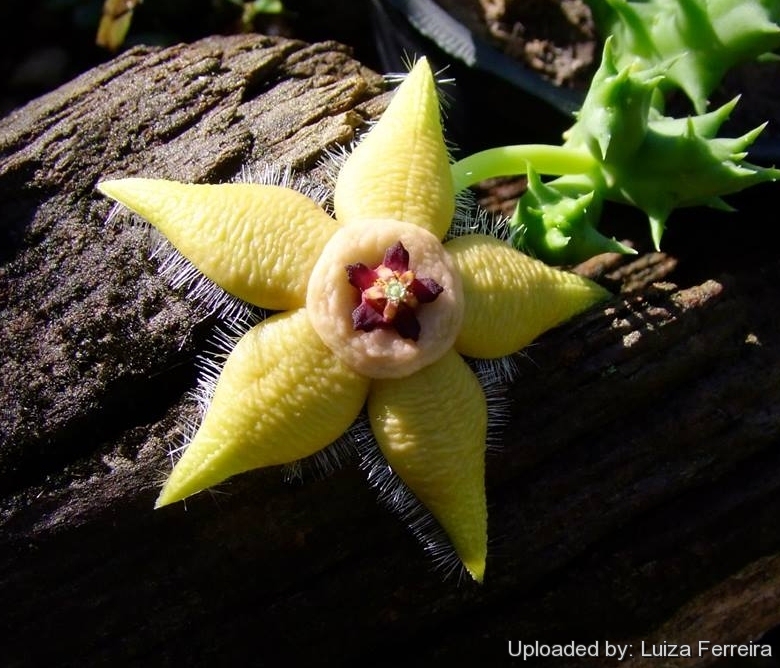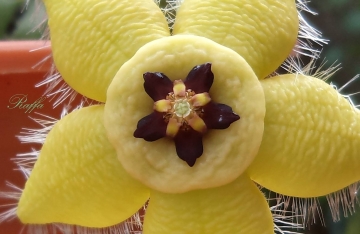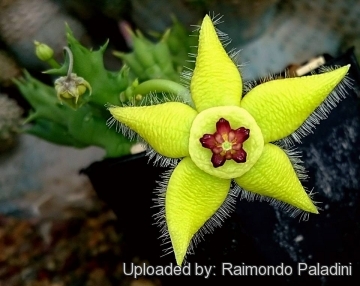Accepted Scientific Name: Orbea semota
Kirkia 10(1): 290 1975

Orbea semota var. lutea Photo by: Luiza Ferreira
Origin and Habitat: Orbea semotaSN|30311]]SN|30311]] var. lutea grows near Nairobi in Kenya.
Habitat and ecology: It grows on rocky outcrops, interlocked with the stems of sparse shrubs, as usually seen with most members of the Stapelieae.
Synonyms:
See all synonyms of Orbea semota
back
Accepted name in llifle Database:Orbea semota (N.E.Br.) L.C.LeachKirkia 10(1): 290 1975Synonymy: 6
Accepted name in llifle Database:Orbea semota subs. orientalis BruynsSyst. Bot. Monogr. 63: 136 (2002)Synonymy: 2
back
Description: Orbea semotaSN|30311]]SN|30311]] var. lutea is the yellow-flowered form of the variable Orbea semotaSN|30311]]SN|30311]] which has received a number of names over the years, now all amalgamated into Orbea semotaSN|30311]]SN|30311]]. This form, which is found near Nairobi in Kenya, is a strikingly beautiful plant with pale yellowish- green, strongly-toothed stems. The brilliant yellow flowers, about 4 cm in diameter, are fringed with simple hairs. The fine hairs flickering in the faintest breeze that cover the surface of the flowers, further enhance the resemblance to carrion, perhaps as an attraction to pollinators.
Habit: Orbea semotaSN|30311]]SN|30311]] is a much-branched, mat forming succulent to 10 cm tall, the stems decurved and rooting freely in contact with the soil.
Stems: Erect or procumbent. 10-18 mm across excluding teeth. Teeth stout, conical, ascending or spreading, to 12 mm long.
Flowers: Solitary or several together, borne from any part of the stem. Corolla star-shaped 3.5-5 cm in diameter, transversely wrinkled uniformly brilliant yellow or yellowhis-green. Limb with a shallow annulus supporting outer corona. Lobes ovate, acute, often recurred along margin, that are are ciliate with vibratile clavate hairs. Outer corona-lobes subquadrate approx. 2 mm long. Inner corona 2 mm high, lying against anther, without extended horns or wing.
Blooming season: Summer-autumn.
Bibliography: Major references and further lectures
1) James Cullen, Sabina G. Knees, H. Suzanne Cubey “The European Garden Flora Flowering Plants: A Manual for the Identification of Plants Cultivated in Europe, Both Out-of-Doors and Under Glass” Cambridge University Press, 11 August 2011
2) Schmelzer, G.H. & Gurib-Fakim, A. “Medicinal plants 2” PROTA, 2013
3) Don Normark, Peggy Park Bernal “The Botanical Gardens at the Huntington” Huntington Library, 2006
4) White & Sloane “The Stapelieae” edn 2 1937
5) Sir William Jackson Hooker “Hooker's Icones Plantarum: Or, Figures, with Brief Descriptive Characters and Remarks, of New Or Rare Plants, Selected from the Author's Herbarium” Longman, Rees, Orme, Brown, Green, & Longman, 1940
6) Excelsa Taxonomic Series 1: 46-8 1978
7) Urs Eggli “Sukkulenten” E. Ulmer, 1994
 Orbea semota var. lutea Photo by: Luiza Ferreira
Orbea semota var. lutea Photo by: Luiza Ferreira Orbea semota var. lutea Photo by: Raffa C. Garcia
Orbea semota var. lutea Photo by: Raffa C. Garcia Orbea semota var. lutea Photo by: Raimondo Paladini
Orbea semota var. lutea Photo by: Raimondo PaladiniSend a photo of this plant.The gallery now contains thousands of pictures, however it is possible to do even more. We are, of course, seeking photos of species not yet shown in the gallery but not only that, we are also looking for better pictures than those already present.
Read More... Cultivation and Propagation: Orbea semotaSN|30311]]SN|30311]] var. lutea is an easy blooming plant when mature that require moderately watering through the growing season but enjoy plenty of water and some fertiliser in hot weather, this helps them to flower freely. Water more sparingly in winter according to temperatures. But, as with most asclepiads, it is unwise to leave them wet in cold weather. Winter care presents no problems at 5°C with plenty of light. Since roots are quite shallow, use a cactus mix or add extra perlite or pumice to regular soil potting soil. A gritty, very free-draining compost is suitable, and clay pots help the plants to dry out between watering.
Sun Exposure: Partial sun or light shade
Pest and diseases: Stapelia species vary in their susceptibility to rotting, but are generally fairly easy to grow, especially if kept pest-free. They are very susceptible to stem and root mealy bugs, and damage from these may well initiate fungal attack. If you do have problems with a stem or with basal rotting, you can reliably isolate the healthy parts, dry them off, and re-root them in moist compost.
Cultural Practices: Re-pot every 2 years
Propagation: Easiest with stem cuttings. Allow cuttings to dry a day before planting. Stems must be laid (Not buried) on gritty compost and will then root from the underside of the stems. It can also be increased from seeds sowing in spring in moist, sandy peat moss.
Potting medium: Since roots are quite shallow, use a cactus mix or add extra perlite or pumice to regular soil potting soil. A gritty, very free-draining compost is suitable, and clay pots help the plants to dry out between watering.













